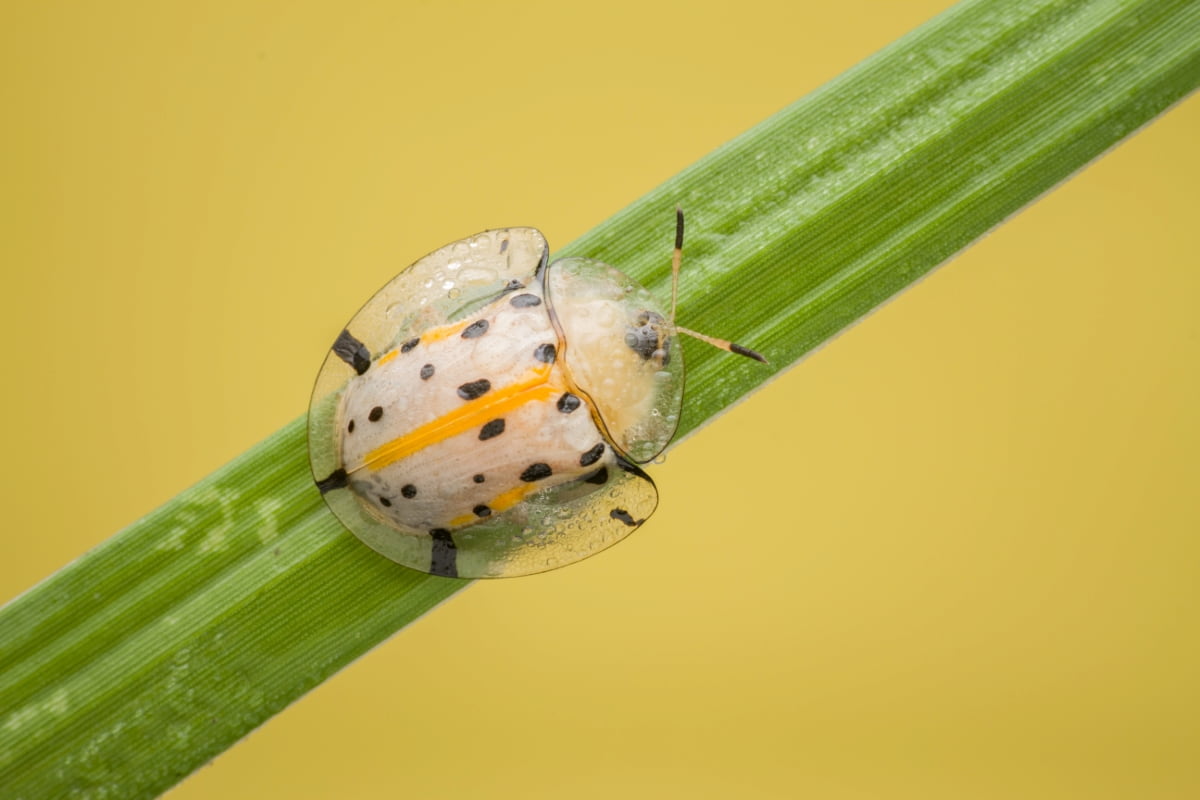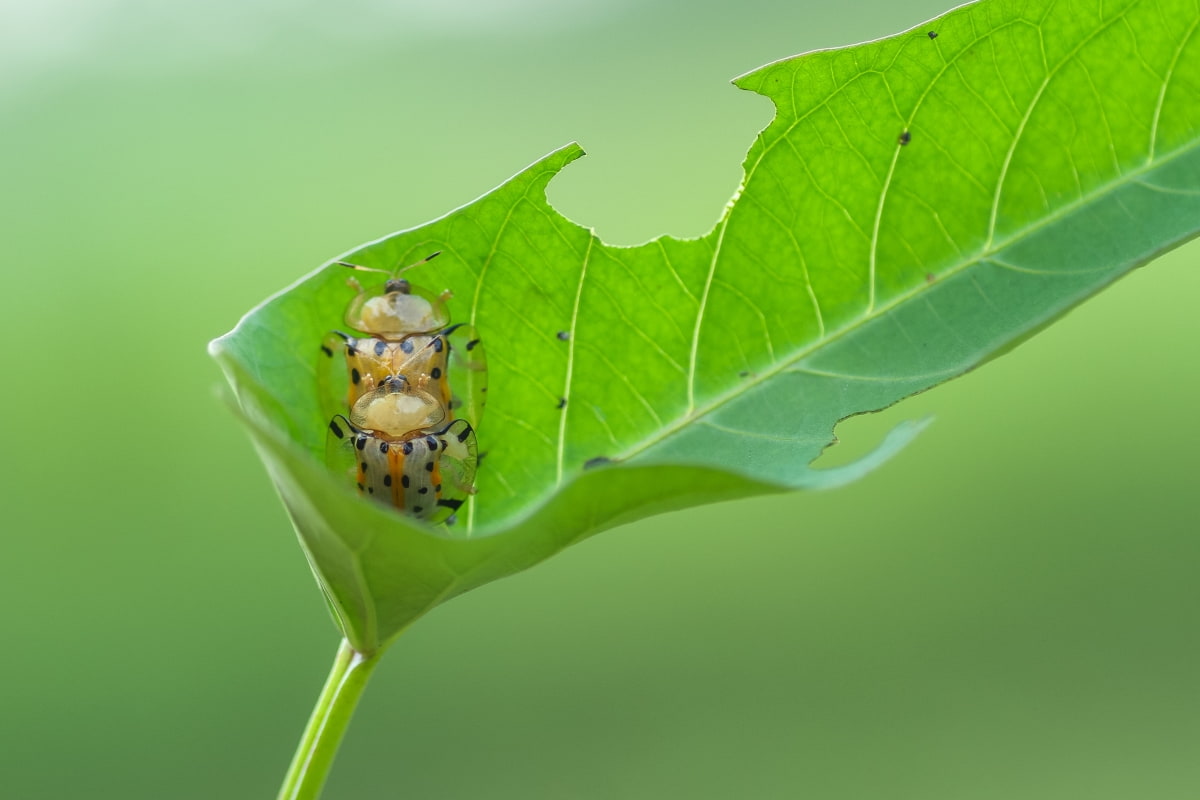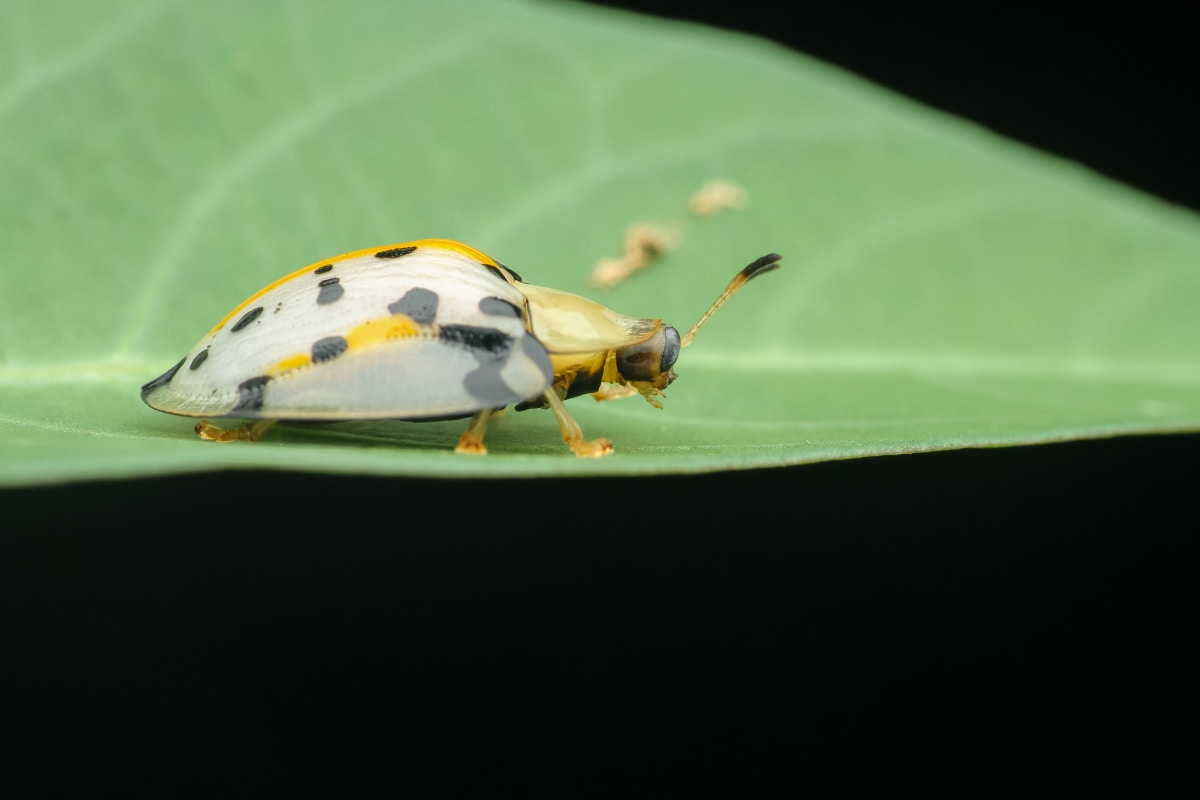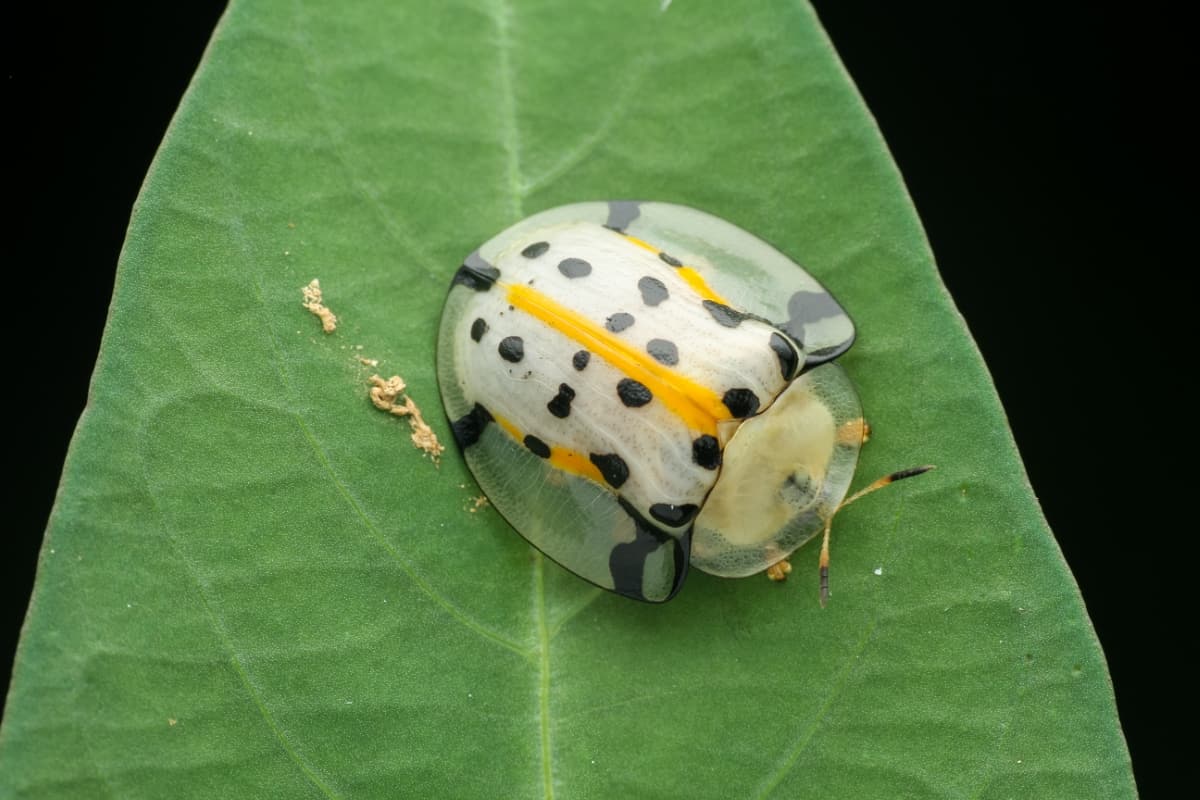Tortoise beetles, belonging to the family Chrysomelidae, are small, oval-shaped insects known for their vibrant colors and unique shell-like appearance. They feed on the leaves of various plants, often skeletonizing them by consuming the tissue between the veins. These beetles can be found on various host plants, making them a common pest in gardens and agricultural fields.
Identifying Tortoise Beetle Damage
Tortoise beetle damage is characterized by the distinctive feeding patterns they leave behind on plant foliage. They typically consume the tissue between leaf veins, resulting in a lace-like appearance. Additionally, the presence of adult beetles and their larvae on the undersides of leaves is a clear indication of infestation. Prompt identification allows for timely intervention to Tortoise Beetle control and prevent further damage to plants.

How to Get Rid of Tortoise Beetle
Immediate Killing Techniques
Manual Removal
Manual Tortoise Beetle removal involves physically picking off tortoise beetles from infested plants. Wear gloves, pick the beetles, and drop them into a container of soapy water to kill them. Check the undersides of leaves where they often hide. This method is effective for small infestations of Tortoise Beetles and can be repeated as necessary to control populations.
Soap and Water Spray
Create a solution by mixing liquid dish soap with water in a spray bottle for getting rid of Tortoise Beetles. Spray the solution directly onto the tortoise beetles and their larvae. The soap disrupts their outer layer, causing them to dehydrate and die. Ensure thorough coverage, especially targeting the undersides of leaves where beetles commonly hide. Repeat the application of this safe Tortoise Beetle spray every few days until the infestation is under control. Don’t spray during peak sunlight hours to prevent leaf damage.
Chemical Control Measures
Insecticides
For chemical control of Tortoise Beetles, choose insecticides specifically labeled for use against tortoise beetles and follow the manufacturer’s instructions carefully. Common active ingredients of effective Tortoise Beetle insecticides include pyrethroids, neonicotinoids, and carbamates. Apply insecticides using a sprayer, ensuring thorough coverage of infested plants. Focus on the undersides of leaves where beetles and their larvae often hide. Reapply as directed, typically every 7-14 days, depending on the product and severity of infestation.
Application Tips
- Before applying insecticides, carefully read and follow all label instructions.
- Choose a calm, dry day for application to minimize drift and ensure proper adherence to plant surfaces.
- Avoid spraying during periods of high wind or rain.
- Wear appropriate protective clothing, including hand gloves, goggles, and a face mask, to avoid skin contact and inhalation of chemicals.
- Rotate between different chemical classes to prevent resistance buildup in pest populations.
Biological Control Strategies
Beneficial Insects
Parasitic wasps of the genus Eucelatoriopsis dimmocki and Tetrastichus and the parasitoid fly prey on Tortoise Beetle infestation. Ladybug species like damsel bugs, assassin bugs, and shield bugs prey on the larvae of tortoise beetles. Release beneficial insects into the affected area and provide habitat and food sources to encourage their establishment and population growth.
Neem Oil
As one of the organic solutions for Tortoise Beetles, Neem oil disrupts the feeding and reproductive behavior of tortoise beetles, ultimately leading to their demise. Additionally, it acts as a repellent, deterring beetles from feeding on treated foliage. Mix neem oil with water as per the label instructions and apply it to infested plants using a sprayer. This organic Tortoise Beetle treatment provides an environmentally friendly alternative to chemical pesticides.
In case you missed it: Homemade Remedies for Tackling Colorado Potato Beetles

Cultural Control Practices
Crop Rotation
It involves planting various crops in a specific sequence over time to disrupt the life cycle of pests like tortoise beetles. Rotate susceptible plants with non-host crops to prevent the buildup of beetle populations. This practice reduces the availability of suitable food sources for beetles, limiting their reproduction and survival. Rotate crops annually or as recommended for optimal pest management and soil fertility.
Proper Garden Hygiene
Maintaining proper garden hygiene is essential for preventing tortoise beetle infestations. Remove plant debris, fallen leaves, and weeds regularly to eliminate potential shelter and breeding sites for beetles. Clean gardening tools and equipment to avoid the spread of pests and diseases between plants. Prune overgrown vegetation to improve airflow and sunlight penetration, creating less favorable conditions for beetle activity.
Physical and Mechanical Barriers
Floating Row Covers
As DIY Tortoise Beetle control, floating row covers create a physical barrier between plants to control pests like tortoise beetles. Install row covers over susceptible crops to prevent beetle access while allowing sunlight, air, and water to reach the plants. Secure the edges of the row covers to the ground to prevent pests from crawling underneath. Monitor plants regularly to ensure proper growth and remove covers once plants have matured sufficiently or when flowering begins to facilitate pollination.
Sticky Traps
Sticky traps are adhesive-coated surfaces designed to capture and immobilize insects like tortoise beetles. For how to kill Tortoise Beetles, place sticky traps near infested plants or along their flight paths to intercept beetles in transit. The traps attract beetles with visual cues or pheromones, causing them to become stuck upon contact. Regularly inspect these Tortoise Beetle repellents and replace traps as needed to maintain effectiveness. Sticky traps are a non-toxic and environmentally friendly method of reducing tortoise beetle populations.
Natural and Organic Options
Diatomaceous Earth
Sprinkle diatomaceous earth around the plant’s base or directly on foliage to create a barrier for preventing Tortoise Beetle damage when tortoise beetles upon contact. This desiccant action dehydrates and kills the beetles without posing harm to plants, animals, or humans. Reapply diatomaceous earth after rain or irrigation, as it becomes ineffective when wet. Use food-grade diatomaceous earth for organic gardening and follow safety precautions, like wearing a mask, to avoid inhaling the fine particles.
Homemade Remedies
Several homemade natural remedies for Tortoise Beetles can help deter and control tortoise beetles organically. Mixtures of garlic, chili peppers, and water sprayed on foliage can repel beetles with their strong odor and taste. Similarly, a solution of neem oil and water applied to plants can disrupt beetle feeding and reproduction. Also, a mixture of dish soap and water can suffocate and kill beetles upon contact.
Monitoring and Early Detection
Regular Inspection of Plants
Check both upper and lower leaf surfaces for signs of beetle activity, including feeding damage, eggs, larvae, and adult beetles. Look for characteristic damage, such as skeletonized leaves and tiny holes. Remove and destroy any beetles, eggs, or larvae found during inspections. Prompt action can prevent infestations from spreading and minimize damage to plants.
Setting Up a Monitoring Schedule
For Tortoise Beetle management, Plan to inspect plants at least once a week during the growing season, increasing frequency during periods of peak beetle activity or when plants are most vulnerable. Use a calendar or gardening journal to record inspection dates and observations. Adjust the monitoring schedule based on weather conditions, plant growth stages, and pest pressure. By staying vigilant and proactive, you can detect tortoise beetle infestations early and implement appropriate control measures effectively.
In case you missed it: Rose Flower Chaffer Beetle Pest Management: Symptoms, Treatment, Chemical, Biological, and Organic Control

Preventive Measures for Future Infestations
Mulching
Mulching is a preventive measure that helps discourage tortoise beetle infestations by creating a barrier between the soil and plant foliage. Apply an organic mulch, such as straw, bark chips, or vermicompost, around the base of plants to inhibit beetle movement and egg-laying activity. This simple practice can significantly reduce the likelihood of tortoise beetle infestations and promote overall plant health in your garden or landscape.
Choosing Resistant Plant Varieties
Selecting tortoise beetle-resistant varieties can help prevent future infestations and the need for pest control measures. Research and choose plant species or cultivars known for their resistance to tortoise beetles based on their genetic traits or chemical defenses. Look for varieties that have been specifically bred or identified for their ability to deter beetle feeding and reproduction.
In case you missed it: Top 10 Homemade Sprays for Bean Beetles: Get Rid of These with DIY Organic Treatment

Conclusion
Combating Tortoise Beetle infestations requires a multi-faceted approach encompassing various strategies. Incorporating natural options and preventive measures ensures long-term success in controlling tortoise beetle populations and preserving plant health.
- Beneficial Insects in Pest Management
- Natural Solutions for Pest Control in Flower Gardens
- Types of Fungicides Used in Agriculture
- Common Issues in the Fruit Development Stage of Pomegranate Farming
- Fruit Development Issues in Papaya: Easy Solutions and Treatment
- Soil-Borne Diseases and How to Protect Your Plants
- Practices to Prevent Disease Spread in the Garden
- From Wilted to Thriving: How to Treat Root Rot Naturally in Houseplants
- Natural Remedies to Cure Brown Spots on Fig Tree Leaves